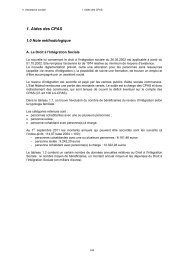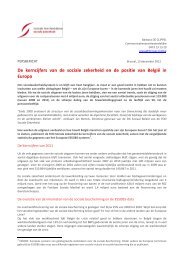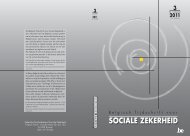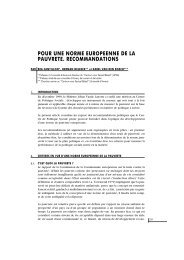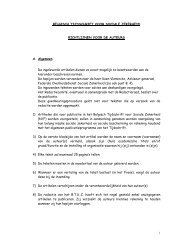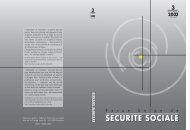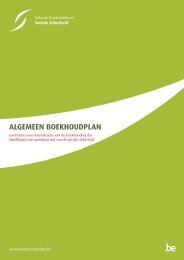social security - FOD Sociale Zekerheid
social security - FOD Sociale Zekerheid
social security - FOD Sociale Zekerheid
- No tags were found...
You also want an ePaper? Increase the reach of your titles
YUMPU automatically turns print PDFs into web optimized ePapers that Google loves.
B.2. Career“Career years” are years qualifying for the calculation of a pension. Apart from the proven activityyears, there are also assimilated periods, with or without payment of contributions. Periods thatare assimilated, without payment of contributions, to periods of employment as a salaried personare, among others: periods of unemployment, sickness and invalidity periods, holiday periods,military service, etc. To assimilate other periods, you have to file an application with the NationalPension Office (RVP - ONP). The study periods after the 20th birthday can also be regularised bymeans of an application with the National pension office (ONP-RVP) within 10 years after thestudies and with payment of a personal contribution.The number of career years that is taken into account for pension calculation should never exceed45 for both women and men. If you have more career years, the least favourable years will notbe taken into account.B.3. Gross salariesApart from the number of career years, gross salaries also play a major part in determiningthe pension amount. Here, we distinguish between the real salaries (salaries on the basis ofwhich the pension amounts were calculated), fictitious salaries (which are related to inactivityperiods that are assimilated) and lump sum salaries.For career years in the period before 1955 (manual workers) or before 1958 (employees),account shall be taken of a lump sum salary. A lump sum salary may also be used for disabledpersons or salaried persons with an accident at work or an occupational disease if that is morefavourable than their real salary.The whole of these salary information is registered on a personal account per salaried worker,which is kept up-to-date by the non-profit organisation Sigedis. Every year, each worker willreceive an excerpt of his personal account.The salaries taken into account for the pension calculation are subject to two treatments. First,they are adapted to the consumer price index. Then, they are also adapted to the generalwelfare level, in order to keep track of the general wealth increase in the population. Thisprocess is called “revaluation”.A maximum limit has also been set. The annual gross salary is only taken into accountup to this limit: the limit is now established at 47,960.29 EUR for 2010. This means thatthe pension itself is limited to a certain maximum amount. There is also a right to a minimumincome. If the person concerned would obtain too low a pension, it can be supplemented. Thisbrings us to the income guarantee for the elderly, which belongs to the field of <strong>social</strong> assistance.The pension calculation of self-employed persons is based on a real or fictitious (for theassimilated periods) lump-sum professional income. For the career years before 1984, afictitious lump-sum income (a fixed amount) per year is taken into account. For the years after1983, the actual income, up to a maximum of 52,378.55 EUR (amount on 1 July 2011), is takeninto account. This actual income is multiplied by a conversion factor that consists out of threeelements. Firstly, the coefficient for revaluation with regard to the index number that appliesat the moment the pension starts, i.e. 60% or 75%. Secondly, the harmonisation coefficient,expressing the ratio between the expenditure for pension benefits and the total expenditure for37



